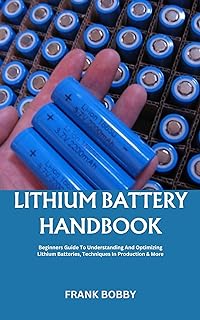Oferta de
LITHIUM BATTERY HANDBOOK: Beginners Guide To Understanding And Optimizing Lithium Batteries, Techniques In Production & More (English Edition)
Mais ofertas de Generico
por
R$ 20,00
* Confira sempre o valor atualizado antes de efetuar a compra.
Mais informações da Oferta
LITHIUM BATTERY HANDBOOK: Beginners Guide To Understanding And Optimizing Lithium Batteries, Techniques In Production & More (English Edition)
The electrochemical mechanism in a lithium battery is based on lithium ions, making it a rechargeable battery. It can store a great deal of electrical energy in a compact and lightweight package, garnering it the moniker "high energy density."The positive (cathode) and negative (anode) electrodes of a lithium battery are separated by an electrolyte. Lithium ions are transferred from the positive electrode across the electrolyte and into the negative electrode when a battery is being charged.
During the discharge process of a battery, electrical energy is discharged as ions flow back to the positive electrode.
The pervasive adoption and growing popularity of lithium batteries can be attributed to their advantages over other battery chemistries. Here are some examples of these advantages:
• Despite their small size, lithium batteries can contain a great deal of energy, making them ideal for use in portable electronics and electric vehicles.
• Lithium batteries are known to outlast their rechargeable counterparts by a significant margin. They can endure more charge-discharge cycles without enduring a discernible capacity loss.
• Due to their low rate of self-discharge, lithium batteries maintain their charge for extended intervals between uses. This allows them to store energy for an extended period of time, making them useful for infrequently used devices.
• Lithium batteries can be charged faster than other battery varieties, making devices more convenient.
• Lithium batteries are adaptable because they can be manufactured in a vast array of configurations to meet a variety of requirements. They are utilized by smartphones, laptops, electric vehicles, renewable energy storage systems, and other applications.
Due to their unique chemical properties, lithium batteries must be handled with extreme caution at all times. Thermal runaway can result in overheating, fire, or explosion if handled inadequately or damaged.
When working with lithium batteries, it is essential to use reliable charging and discharging systems and to adhere to all applicable safety regulations.




